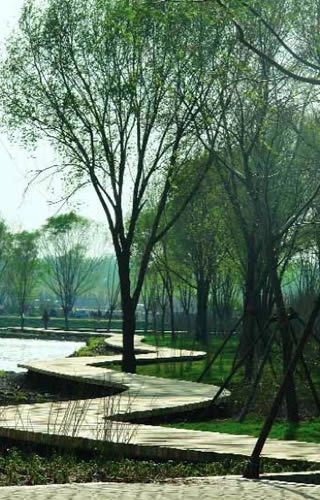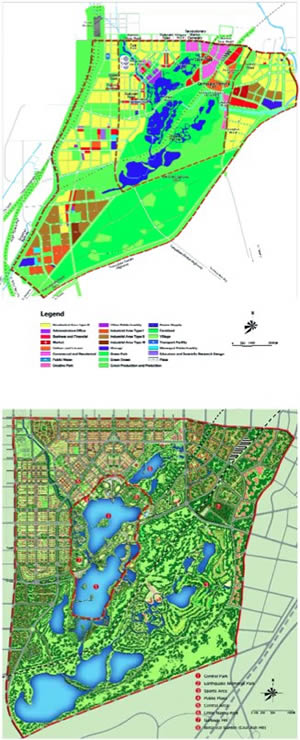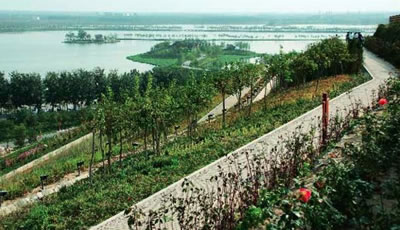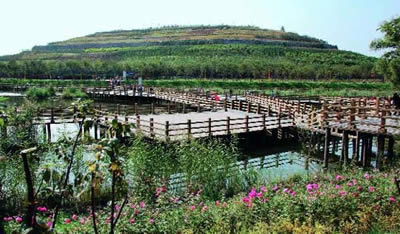编者按:一年之内,这块曾是采煤区的土地如今成为一片宝贵的公共公园,同时也成为了发展南湖生态城的提速剂。
Within only one year a former mined area in Tangshan, southeast of Beijing, was transformed into a valuable 5.9 square kilometer public parkland that has become the catalyst for the development of the South Lake Eco-Town.
Article Source: Zheng, Xiaodi. South Lake Central Park. TOPOS, VOL. 69. December, 2009.
声明:此文为正式授权文章,已征得作者同意在风景园林新青年(Youth Landscape Architecture)上发表,不得转载,需要授权转载发布者,请联系作者或TOPOS杂志(www.topos.de)
Notice: This article is a reprinted version with the official permission of the author. Do not copy without permission.

Tangshan, 200 kilometers southeast of Beijing, is an important heavy industrial coastal city in Hebei Province,North China.With a manufacturing history of over 100 years, the city is known as the birthplace for China’s modern industry. In 1877, the first mechanized coal mine, Kaiping Coal Mine (later known as Kailuan Coal Mine) was built in Tangshan, which established coal mining as one of the pillar industries in the city.
While the city was booming, an earthquake registering 7.8 magnitude hit unexpectedly in early morning of 28 July 1976.More than 240,000 people lost their lives, with 160,000 critically injured – making it the deadliest earthquake of the 20th century. It leveled most of the city, destroying 93 percent of residential buildings and damaging infrastructure throughout.With a 30-year effort of restoration and construction, the city was able to rebuild and was granted the United Nations’ Habitat Scroll of Honor Award in 1990.
According to the Tangshan city government website, the city’s GDP and overall financial revenue in 2006 exceeded 236.2 billion RMB (34.5 billion US dollars) and 26.4 billion RMB (3.87 billion US dollars). Now, however, the cost of years of natural resource exploitation is evident. More than 100 square kilometers of land collapsed within the city range due to coal mine excavations. An area of 28 square kilometers sunk within the South Lake District south of downtown Tangshan. Due to the high elevation of groundwater in this region, a sink hole was formed. Additionally, the area, used as the city’s landfill for decades, contained earthquake debris, construction and domestic waste, as well as coal dust. A volume of 289,800 tons of waste material was disposed here annually. Immediately before its closure, the landfill held 4.5 million tons of garbage, which formed a mound as tall as 50 meters. Unbearable living conditions forced many residents to relocate.

The South Lake District has long been regarded as a foul, contaminated and derelict area that is almost impossible to develop.However, the city’s population is growing and the demand for developed land is high. In 1996, the city made its first attempt to remediate a 130 hectare site in the South Lake District and develop it into the Little South Lake Park. Through years of effort, this park has proved to be a big success and was awarded the Dubai International Award for Best Practices in 2004 for improvement of the environment. Not only does it show the public and city authorities that this wasted land could be remediated and transformed into valuable public space, but also the intense public usage reveals citizens’ high demand for more open space in the city. From 2004 to 2005, the Tangshan Planning Bureau organised an international competition on Urban Design for South Lake District. First prize went to the office of Latz + Partner, Germany, whose proposal called for a large water surface and two “ribbons of leisure”, with one along the road system and the other along the lake.
High demands for development

The final push for the realisation of South Lake Park came from the strong political wish of city administrators. In October 2006, Yong Zhao stepped up as the new party secretary of Tangshan city. Shortly after, a series of moves were made regarding the city’s development. The South Lake district and its surrounding area of 91 square kilometers were named as the South Lake Eco-Town with a set of sustainable approaches planned.The following year the Hebei provincial government set a new goal for cities to improve their urban appearance as “A great leap each year; a dramatic change in three years.” South Lake Eco-Town became one of four new towns to be developed in Tangshan. A seismic microzoning report by Tangshan Seismological Bureau and a geological hazard risk assessment by Tangshan Land and Resources Bureau revealed that the majority of land in South Lake Eco-Town district had reached a stable status and was ready for development.
In early 2008, Peng Lin became the new director of the Urban and Rural Planning Bureau of Tangshan and was faced with the urgent task of making a “dramatic change” to the city’s image within three years. An international competition was held in October for the master plan of the 91 square kilometer South Lake Eco-Town. Four design institutions were invited: China Academy of Urban Planning & Design, Beijing Tsinghua Urban Planning & Design Institute (THUPDI), ISA Internationales Stadtbauatelier, and J.A.O. Design International Architects & Planners. Planning proposals were submitted in January 2009. As a result of this competition, each participant received a piece of the project for further development.
THUPDI worked on the eco-town central core,which occupies an area of 38.8 square kilometers, including the future administration, business and financial center; materials distribution and delivery center; and residential area, as well as the 28 square kilometer South Lake Ecological Park. THUPDI collaborated with China Coal Research Institute Tangshan Branch, The Institute of Crustal Dynamics in China Earthquake Administration and Kailuan Group. The stability of each land parcel and its suitability for supporting permanent structures were identified via a comprehensive analysis of various factors, including: land use, earthquake fault zone, mine subsidence areas, land permeability, soil productivity, biological diversity, surface water system and landscape visual value, etcetera.

A detailed master plan of the core area was delivered in February and received a warm reception from city authorities. Still recovering from the extensive work to prepare their submission for the core area planning, the design team was notified with the important yet startling news that their depiction of the park looked so convincing that government administrators had decided to build it immediately. The opening date of the 5.9 square kilometer South Lake Central Park (the first phase of South Lake Ecological Park) was set for 1 May 2009 to welcome the International Labour Day crowd.
Efficient construction methods
To meet this urgent deadline, THUPDI sent an on-site design team of six to Tangshan on 10 February. It was comprised of a senior consultant in charge of construction documents and supervision, a project manager and four landscape designers. They lived near the project site and worked in an on-site office to generate construction details, respond to unexpected site conditions, coordinate with contractors and civil engineers and report to city officials on project progress.To facilitate the park’s construction, the government also assigned specific city officials to conduct “five on-site working methods” including: official working on-site, decision carried into action on-site, problems solved on-site, innovation encouraged on-site and achievements appraised on-site. As a heavy industrial city, Tangshan is well supplied with heavy construction and delivery machinery. The municipal government made full use of this and gathered all necessary construction teams on the park site. At times 500 heavy pieces of equipment and trucks were working simultaneously, and more than four million cubic meters of coal dust was removed in three days. Through these great efforts, the official public opening occurred on 1 May 2009.
The park design

The most stunning focus of South Lake Central Park is its two square kilometer water body, which hosts a variety of water activities. The park’s north and northwest edges border the future administrative center. A grand plaza is designed to serve as the forecourt of the administrative center and provide a gathering space for large events. The coal dust hill sitting on the northeast border of the park will become a botanical garden. South of the garden, a diagonal road bisecting the lake travels southwest and connects to the Phoenix Terrace (the former waste site) on the west edge of the park. Approximately 80 million RMB (11.72 million US dollars) was spent to reclaim the landfill, with Shanghai Municipal Engineering Design Institute taking charge of the cleaning process and THUPDI overseeing the planting scheme. The apex of Phoenix Terrace has become the best spot for viewing the entire scheme. Inspired by traditional Chinese landscapes, several islands were created in the center of the lake to preserve existing groves of trees, while some feature tea houses, pagodas, and an amphitheater.
Ecological Park has lived up to its name. Many ecological measures were implemented during the park’s creation; this helped to condense the construction period. Most existing vegetation was preserved and native species were identified and bought from local nurseries. The huge amount of coal dust accumulated on the site was used to create land forms and to build foundations for pathways. The remainder was sold to local factories for cement and concrete production. A new technology was applied to the formation of the lake banks. Utilizing dead tree trunks, stems and branches to form a grid to hold soil in place, it provides habitat for insects. Terraced pedestrian pathways lead down from the Phoenix Terrace to the central lake with its newly constructed islands.The former landfill is completely covered by green and aquatic organisms. No concrete or brick was used to create hard water edges, which saved materials transportation labor, reduced environmental pollution and shortened the construction cycle. Street lamps are solar powered and the visitor shuttles are electric powered. “The South Lake Central Park aims to reclaim this derelict land and to restore its ecosystems on multiple levels. The goal is to integrate history, culture, ecology and recreation; to provide a healthy and vibrant open space the local residents have longed for; and to go one step further in building a more sustainable environment,” stated Jie Hu, chief designer of the park and director of the Planning & Design Branch of Landscape Architecture in THUPDI.
The South Lake Eco-Town is expected to be completed by 2015 and support a population of 400,000. South Lake Central Park has become a catalyst to accelerate this development. Standing atop Phoenix Terrace,overlooking the crowds enjoying the park, one can’t help being amazed that this city green was created within one year.However, one might also wonder whether it was necessary to set the tight deadline, abbreviate the design phase, and hasten the construction process. Are instant landscapes sustainable? While the power to decide how fast landscapes need to be constructed is out of the hands of landscape architects in China, a more practical perspective would be to examine how they can participate in this process and influence the final result.
额。。。有点儿好奇,这次的没有翻译么?
@Dorinda07, 中国的项目,就没有组织翻译了。
@钟惠城, 哈~原来是这样,不过还好不算难~勉强看懂。。不过觉得对生态方面的介绍略少啊。。煤矿开采后的生态改善应该是最重要的吧……
@Dorinda07, 大家可以都来看看,怎么把自己国内的项目往外写。
最精彩应属最后一段引出的思考和话题:站在凤凰山上,眺望着使用公园的人群,人们不禁惊叹于这块城市绿地一年里发生的变化。然而,人们也想知道,到底是否真的需要为其赋予如此紧张的期限、简化设计阶段、缩短建设周期?这样的景观真的可持续吗?
偶的亲爱的家乡,必须顶~不过很久没回去了,去年的时候还是很漂亮滴~
其实并不如想象中的好,凤凰山的那个形体也比较囧
@凤梨罐头, 临时绿化。。。
过一段时间给大家讲“凤凰涅槃”的故事——————寻根溯源唐山南湖的变迁……
@安友丰, 强烈支持!!
@安友丰, 期待安老师的开讲。。。
看到南湖垃圾山有些感慨~~~~小城同志理解啊
@冯潇, 恩那呵呵,以后咱要重游一次!